President's Message
We are still unpacking!!! In our last newsletter I reported we were moving our office to Dabbs House Museum. As with any move, whether it is personal or professional, we find things of interest, sometimes long forgotten. I would like to share one of those finds from the HCHS office (contributor unknown.)
The following letter was written by Count Segur, the son of Philippe Henri de Segur, the French Minister of War under Louis XVI. The Count was given a commission of Lieutenant Colonel with two battalions of recruits to help us gain our independence. After the war, as he was leaving this country, which he really loved, he wrote:
"This is the day on which I set sail; I am quitting with infinite regret a country where, without obstacle or difficulty, we are, what every where else we ought to be, sincere and free. Here all private interests merge to the general welfare; every one lives for himself, dresses as he pleases, not as it pleases fashion. People here think, say and do what they like. Nothing compels them to submit to the caprices of fortune or power. The law protects the individual against the will of all; and nothing obliges anyone to be deceitful, humble or cringing. Everybody may at pleasure be plain or singular, court solitude or society; live as traveler, politician, literary character, or as merchant without either being disturbed in his occupation or molested in his idleness. There exists no restraint beyond that of a very limited number of just laws which are equally dispensed to all, and all enjoy peace, happiness and consideration, as long as they respect house laws and public morals... Although beset by the storms of a civil war, the Americans so little suspect mankind of immorality which their own minds cannot conceive, that in their small dwelling houses, isolated in the midst of immense forest, the doors have no bolts, and are kept shut by latches only. The stranger whom they admit to lodge with them, together with their servants, find all their presses and wardrobes left open though filled with money and apparel They allow their guests to walk about for whole days along with their daughters of sixteen years of age, who have no other protection that their modesty... I shall perhaps be told that America will not always preserve such purity morals; but were she to retain them no longer than a century, is a century of happiness so inconsiderable a blessing?"
Louis Philippe, comte de Segur (10 December 1753 - 27 August 1830) was a French diplomat and historian. Segur was born in Pan the son of Philippe Henri, marquis de Segur and Louise Anne Madeleine de Vernon. He entered the army in 1769, served in the American War of Independence in 1781 as a colonel under Lieutenant General Jean Baptiste Donatien de Vimeur, Comte de Rochambeau.
Count Segur's words, written long ago, certainly give pause for thought. May God Bless America.
Sarah Pace,
President
>Back to Top<
One-year Membership Dues are as Follows
Individuals $15.00
Family $20.00
Student or Child $5.00
Supporting $25.00
Sustaining $50.00
Corporate $100.00
Benefactor $300.00
Lifetime $500.00
Make checks payable to
Henrico County Historical Society
P.O. Box 90775
Henrico VA 23273-0075
>Back to Top<
In Memorium: Jean Gray Nelson Gibbons
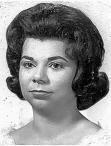
Founder and life member of the Henrico County Historical Society.
October 12, 1931 to May 27, 2015.
>Back to Top<
September Quarterly Meeting
Sunday, September 13, 2015, 2:00 p.m.
Antioch Baptist Church
3868 Antioch Church Road
Sandston, VA 23150
We will meet for the dedication ceremony (originally planned for March 1 but cancelled) of the War of 1812 state highway marker in Henrico County that will be designated as part of the War of 1812 Heritage Trail. The Virginia Department of Historic Resources and the Virginia Bicentennial of the American War of 1812 Commission partnered to sponsor a series of historic markers throughout the state in recognition of the bicentennial commemoration of the War of 1812.
It is time to elect HCHS officers. Please be ready to vote and/or nominate at our next meeting.
>Back to Top<
June HCHS Meeting Features Literary and Legal Worlds
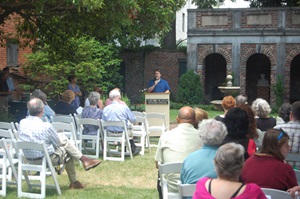
HCHS members assembled at the Poe Museum on East Main Street, the oldest structure in the city. Before touring the facility, they met in the garden for a presentation about Edgar Allan Poe by museum curator Chris Semtner.
Then the members hiked up Main Street to the old Henrico County Courthouse and the adjoining old jail at 22nd and Main. After hearing Mr. Kim Zimmerman, the present owner of both properties, talk about the building and work he has done inside, members were let in to roam the building.
Inside, members entered the long, sweeping, double-arched room that had once served as office space. Passing through the archway and scaling the two-level staircase, visitors reached the second floor. At the back of the second floor was the large main courtroom with its arched windows.
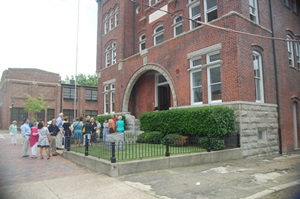
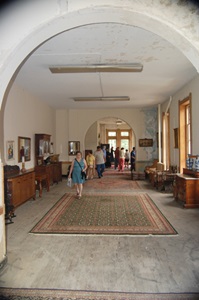
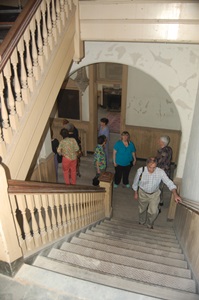
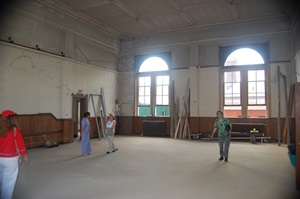
>Back to Top<
Donation
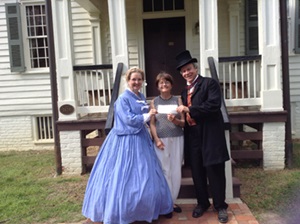
Cheryl Dale, Sarah Pace and Tom Karow pose in front of the Meadow Farm house with a check from the 12th Virginia Infantry Company B for the kitchen project.
>Back to Top<
APHA Seeks to Save 1854 Henrico Structure
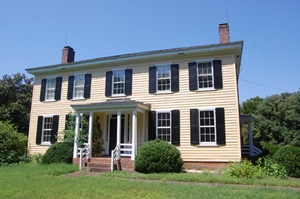
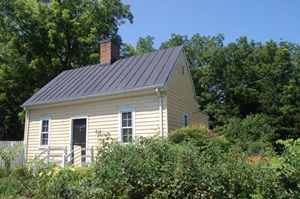
Before the bulldozers move in and development begins on the property in September, the Association for the Preservation of Henrico Antiquities is at work documenting the structural details and marking them in preparation for the dismantling of Burleigh and the cottage on its grounds. The main house was built in 1854, while the smaller building dates to an even earlier period and possibly served as the residence before the main house was constructed. APHA president Dr. Henry L. Nelson, Jr. is working with Chuck Peple and Terry Shackleford on the project. Plans call for the dismantling and storage of the materials in hopes of finding a party interested in reconstructing the buildings at another appropriate location.
>Back to Top<
A Colorful Rogue Captures the Public's Attention in a One-man Henrico Jailbreak
Jailbreaks and jailbreakers-both real and fictional - seem to hold an odd fascination for us. In the cinematic world we have the wrongly convicted Andy Dufresne of The Shawshank Redemption, the loveable rogue Luke Jackson of Cool Hand Luke and the ultra-cool characters of Henri Charriere and Capt. Virgil Hilts played by Steve McQueen in Papillon and The Great Escape, respectively.
And two dramatic real escapes have recently captured the public's attention. National news exhaustively covered both the escape by the two convicted murderers from the maximum security Clinton Correctional Facility in upstate New York and the escape through a near-mile-long tunnel by drug king-pin El Chapo from what was touted as Mexico's most secure maximum security prison.
The Henrico County jail in the early twentieth century was by no means a maximum security facility, but a 1902 escape featured a local, almost lovable rogue, a clever plan and a fair amount of media coverage. It was the afternoon of Sunday, December 28, 1902 that John St. John, better known as Gypsy Jack. Jr., was in jail awaiting trial and was the only inmate to take advantage of the of the daily, unsupervised exercise time the jail yard. The presence of a forty-foot wall around the yard seemed to the authorities to be security enough. However, Gypsy Jack took advantage of the lax security and the actual design to cut short his incarceration and enjoy a period of freedom. The escape caused the Times-Dispatch of Sunday, January 4, 1903 to headline its story "It Is A Poor Prison: Henrico Jail Adjudged No Longer Safe." The article explained that the escape was not especially daring: "It is a very simple matter for a prisoner to stand on the ground and throw himself up into the first window, and by climbing up the cross-bars the sill of the window above would be in easy reach. All he would have to do then is to climb the bars on this window and gain the top of the building He could then run along the roof until he reached the kitchen, which is several feet below the jail, and when he arrives here he is within a few feet of a shed which is only ten feet from the ground and an easy jump. This shed being in an obscure place, it would be easy for him to make an exit without being seen."
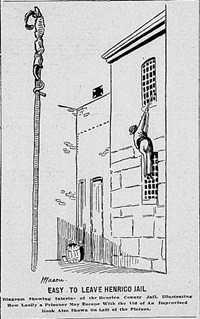
Up up and away. This illustration from the January 4, 1903 Times-Dispatch depicts Gypsy Jack's method of escape and the implement he fashioned to accomplish it.
An escapee in October of that same year had used the same tactic, but Gypsy Jack had been forced to vary the plan a bit. Being too short to reach the first tier of windows, he had used a broomstick and piece of heavy wire to fashion a hook (apparently, somewhat like a shepherd's crook), which he used to grab the bars and hoist himself up. His ingenuity and his checkered history apparently made him a sort of minor media darling, earning the story a sizeable illustration of Jack's climb and his implement. The Richmond Times gave evidence of St. John's local notoriety by using his colorful sobriquet in announcing his escape claiming in its headline of Tuesday, December 30, 1902, "Gypsy Jack is too Fly for the Henrico Authorities."
Readers of Richmond's papers had had a passing acquaintance with Gypsy Jack, Jr. for a number of years due to his involvement in many fairly petty crimes and the appearance of his name in newspaper articles about them. For example, The Richmond Times reported on March 11, 1900 that St. John had been "arrested yesterday morning by W. D. Schlief as a suspicious character. The cause of the arrest was that St. John was discovered yesterday morning with a wagon load of junk supposed to have been taken from the shop of C. J. Fox at the foot of Twenty-ninth Street." And the Times of March 15 indicated that the material was a load of iron that he sold for three dollars. The outcome of the run-in is not known, but the Richmond Dispatch of May 18, 1900 indicated that he had been acquitted of highway robbery.
Later, the Richmond Dispatch of June 6, 1900 ran a brief piece noting that he had been arrested for stealing a coat valued at one dollar from a Max Franklin. Less than two weeks later, the June 19 Richmond Dispatch reported that "John St. John, who is known as 'Gypsy Jack,' who has been at work in the chain-gang quietly walked off yesterday to see the show." It seems that "the show" had a fairly long run because the August 29 edition followed up on the story, announcing that Gypsy Jack "was returned to serve his old sentence."
It wasn't long before he was in court again, but this time as a plaintiff, and the company he kept seems indicative of his nature. According to the January 12, 1901 Times, Junius Baker "was charged by John St. John with taking $8 from his pocket." Baker testified that "he found the money on the floor of the room in which both of them slept. St. John was asleep, and . . . knowing the money belonged to him, tried to awaken him so he could give him the money. He couldn't awaken him, however, so he put the money in his own pocket for safe-keeping and went on out." It was a story of dubious credibility, and one can almost imagine the judge stifling a laugh, but he "honorably acquited" Baker.
By September 9 of that year, John St. John was getting headlines again, the Times ran a story entitled "Many Crap Shooters: Nineteen of Them With 'Gypsy Jack' Were Features in Police Court." While there is no mention of the gamblers' names, the star of the day was identified as "famous as a police character" who "has been away lately, and when he once more returned to Justice Crutchfield he got his usual time, sixty days."
Then came the event that led to his confinement in and then escape from the Henrico County jail. Under the heading "Stole His Mother's Horse," the Richmond Dispatch of November 11, 1902 began, "On the charge of stealing a horse from his own mother and $42 and three rings from John McKee, John St. John, Jr., son of Gypsy Jack [see note below] is now behind the bars in the county jail." St. John and McKee were both "members of the gypsy camp, which is located on the Hermitage road, about one mile from the city." St. John was given a hearing on the horse-stealing charge, and the case was continued. The other count was sent to the grand jury. The Richmond Dispatch of December 7, identified the horse owner as St. John's step-mother, noted that the charge was dismissed, but said that "On the other charge he will have to answer to the grand jury."
So the stage was set for Gypsy Jack's escape, but his flight from captivity was not the end of that story—he had one more escape to make. From the jail, St. John eventually made his way to Norfolk, where he was captured. The Times-Dispatch of January 28, 1903 somewhat lightheartedly said,"Some time ago this fertile young man manifested a decided distaste to continued confinement in the jail, and finally one day he stole quietly away." The report continued, "Sheriff Simon Solomon went down, got Gypsy Jack and started back with him. But again did his baggage exhibit a rare sensitiveness as he approached the jail. The train pulled into town about 7 o'clock, and then Gypsy Jack stole away again. He darted under the train and before the sheriff could pull himself about he was gone. Mr. Solomon snapped his pistol several times, but it wouldn't explode. Then in supreme disgust he went to the courthouse alone and began to lay plans for the recapture of the elusive transgressor."
By July, Gypsy Jack had been captured in Baltimore and returned to stand trial in Henrico County Court. The July 14, 1903 Times-Dispatch referred to him as "the slippery chap who has given the authorities of Henrico so much trouble" and reported that he pleaded guilty to grand larceny and was sentenced to one year in the penitentiary.
Time in the penitentiary didn't reform John St. John, but did seem to keep a rather low profile, at least for a few years. But by 1906, he was back in jail and oddly protective of his and his family's honor, defending it with a knife he somehow had in jail. According to the April 17, 1906 Times-Dispatch, "John St. John, or 'Gypsy Jack, Jr.,' as he is known to all of Richmond made a tellible lunge through the bars of his cell at Mortimer True, a man who had been instrumental in securing his conviction and who taunted him with the fact." According to Gypsy Jack, "He came to my cell and abused me terribly. Not only did he taunt me about being in jail, but he said something about my mother and about my father that no man can say to my face." When asked by Judge Crutchfield (the same judge of the crap shooters trial) where he got the knife, Gypsy Jack offered a story whose credibility rivaled that of Junius Baker's excuse for having his eight dollars: "I - ah - I bought the knife in jail."
His righteous indignation turned to begging on bended knee the next time he was in court. On October 26, 1906, the Times-Dispatch reported on a trial in Police Court of John St. John, "well known to the police as 'Gypsy Jack' ," who "For many years has belied his saintly name by figuring in the Police Court in all cases from a bar-room fight to horse-stealing." It seems that in a downtown lunchroom St. John had asked George Harrison for some money with which to eat, got the money and left. Harrison then noticed his gold watch was missing, and his suspicions were aroused when St. John returned and offered to buy him a drink. Arrested and going to a higher court, "St. John got down on his knees and begged to be sent to jail for one year, instead of running a chance of the penitentiary."
It is in that higher court where we last hear of Gypsy Jack. His earlier plea can be well understood when we find that his second trip to the penitentiary would earn him an extra five years tacked on to any sentence assigned. The November 11, 1906 Times-Dispatch identified him as the person "who since the age of ten years has been breaking into trouble." Having been found guilty of stealing the watch, he received a five-year sentence in the penitentiary, with an extra five added for his second imprisonment. Bemoaning his fate and offering a curious defense and excuse similar to Junius Baker's reason for having his eight dollars, Gypsy Jack said, "I'll never come out of that place alive . . . when I was over there before for one year I stayed in the hospital for two months, and they'll bury me there this time. I didn't steal that watch, but I might have done it if I had got a chance. The other fellow stole it and gave it to me to sell."
Off he went to prison and into obscurity. But for a brief time he provided the denizens of Richmond with an entertaining glimpse of life on the shady side of the street. But why did he, his escape and his other exploits garner the interest that they did? With the exception of his feckless lunge at the insulting jail visitor, his actions were not heinous, the stories not lurid, his crimes not major. His escape was not even one of blockbuster proportions. Perhaps, Gypsy Jack shows us something about ourselves. Interest in a rather harmless, small¬time criminal is a fairly safe guilty pleasure. We can indulge in that while we maintain a sense of moral superiority, allowing us to use an almost playful tone in describing his endeavors. Are we possibly a little jealous of such a seemingly uninhibited character and yearn to secretly at least bend the rules? Is our fascination rooted in a basic aversion to confinement and desire for freedom, whether deserved or not? Or is it all just a really good story?
Note: William St. John, John St, John's father, was a Richmond horse trader who was originally known as Gypsy Jack. In his early exploits, his son John was at first dubbed Gypsy Jack, Jr.; but over time newpaper accounts dropped the "Jr." and simply referred to him as Gypsy Jack. This is cause for some confusion, since the name "Gypsy Jack" sometimes refers to the father and other times to the son. The next issue of the newsletter will include a treatment of the also colorful original Gypsy Jack.
Joey Boehling
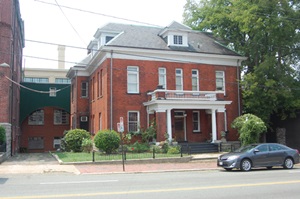
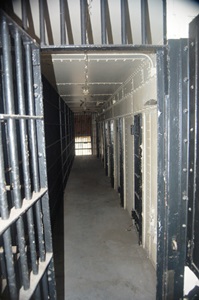
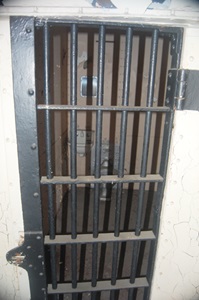
Henrico Jail - Inside & Out.
Top left: The exterior of the old Henrico County Jail at 2117 East Main Street, now the home of Mr. Kim Zimmerman.
Bottom Left: One of the cell blocks in the building.
Bottom Right: A view of one of the individual cells.
>Back to Top<
Now You Know
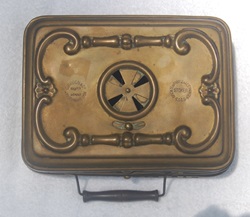
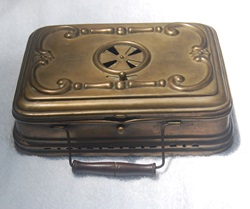
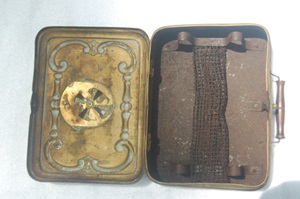
With a brass carriage warmer, travelers were cruising in style and warmth.
Congratulations to Haywood and Mary Jo Wigglesworth and Nancy Grubbs, all of whom identified the last issue's mystery object as a warmer.
This upscale French warmer was to be used in a carriage.
It was made of brass and featured a removable mesh container inside. Before one's journey, coals would be placed in the container, and then the container was secured inside the case. The adjustable vent at the top of the warmer allowed a bit of heat adjustment.
Passengers would use the device to warm the carriage seat. or they could put it on the floor and warm their feet.
>Back to Top<
What Do You Know?
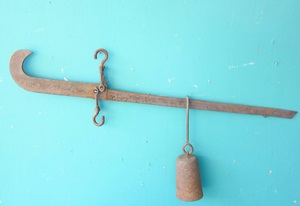
This object is made of iron. It is approximately 4 feet long, and its top edge is slightly serrated.
Do you know what it is called and what it was used for?
Email your answers to jboehling@verizon.net.
>Back to Top<
News 2015: Third Quarter
First Quarter | Second Quarter | Fourth Quarter
Home | Henrico | Maps | Genealogy | Preservation | Membership | Shopping | HCHS
|











